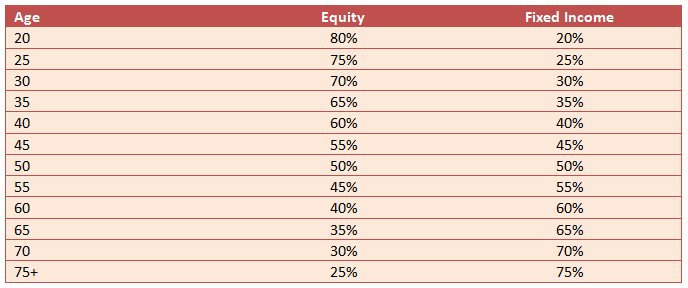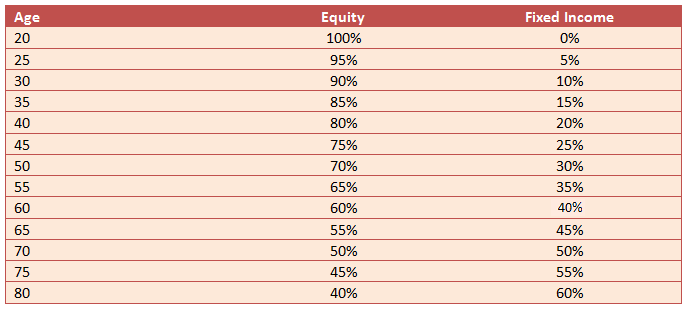Simple asset allocation strategies for different risk profiles

In our blog, we have often discussed that asset allocation is the single most important factor in ensuring success of our financial goals. In the broader sense, asset allocation includes a variety of asset classes like equity, fixed income, gold and real estate. Equity, fixed income and cash / cash equivalents, however, are the three most important asset classes for retail investors because these are financial assets. The other asset classes in India are primarily physical assets and have different investment purposes. In this post, we will refer to asset allocation in terms of equity and fixed income only.
Your asset allocation should be specific to your financial situation and your goal time horizon. For example, if you are on a sabbatical from work for a certain period of time or a young retiree, your asset allocation should be on the conservative side (high percentage of fixed income), because you cannot expose your lifestyle to the vagaries of the stock market. If you are a businessman / entrepreneur and your income is seasonal (lumped at particular times during a year), then you need to have significant cash equivalents (e.g. savings bank, money market mutual funds) to sustain your income needs during the lean periods. If your goal time horizon is very long, then equity is the best asset class. On the other hand, if you are approaching a goal timeline, then you should shift to fixed income so that your goal is not compromised by volatility in stock market. The financial situation and goals differ from individual to individual. In this post, we will discuss some simple asset allocation strategies for some generic risk profiles. You can use these as applicable and modify them to your specific needs.
Asset Allocation based on Max Loss Percentage
We know that, equity is a risky asset class. Different individuals have different risk appetites. High and low risk appetites are fairly subjective in terms of interpretation by individual investors. The concept of Maximum Loss Percentage brings some quantitative objectivity to evaluation of risk appetites. Maximum Loss Percentage, as the name suggest, is the maximum portfolio (which includes both equity and fixed income) loss than you can suffer, without causing any emotional or financial distress to you. Emotional or financial distress can cause investors to trigger panic selling, which causes further harm to investors. Maximum loss percentage will differ from investor to investor depending on their risk capacities and risk attitudes. For some investors it can be 5%, while for others it can be 50% or even higher.
The formula of equity allocation in terms of Maximum Loss Percentage is as follows:-

What is the Maximum Market Loss? This is the worst case scenario for the market. For most investors, 2008 was the worst bear market in our lifetimes. The Sensex fell by 60% from January to November 2008. The asset allocation based on a 2008 like scenario will prepare us for the worst.
Let us walk through an example to see how the formula works. Let us assume that your maximum loss percentage is 20%, in other words you are ready to suffer 20% reduction in your total portfolio value without panicking even in nightmare scenario like 2008. Let us assume that, the risk free rate (fixed deposit rate) is 8%. Your equity allocation based on Maximum Loss Percentage will be (20% + 8%) divided by (60% + 8%) or 41%. This is the maximum equity exposure you will have. Let us examine a scenario where the market falls by say 35%. Your asset allocation, as discussed earlier, is 59% fixed income and 41% equity. Your portfolio loss will be (59% X 8%) – (41% X 35%) or -9.6%, well within your tolerable limit. Even if the market falls by 50% your loss will -15.8%, still within your tolerable limit.
If you are young and have stable income from your profession or business, you can have a high maximum loss percentage (even as high as 50% or more, depending on your financial situation), because you can afford to wait longer for the market to recover and recoup your losses. On the other hand, if you are nearing retirement or approaching important goal timelines (like children’s higher education, marriage etc), you probably cannot wait very long and hence you will have a lower maximum loss tolerance. Asset allocation based on Maximum Loss Percentage, though fairly intuitive, is quite practical because it is based on how investors react in very adverse situations and protects their interest in such situations.
Age Based Asset Allocation Strategies
The Rule of 100 is a popular asset allocation thumb rule and based on ample evidence, very effective too. Simply put, you should subtract your age from 100, and the result suggests the maximum percentage amount of your portfolio that should be exposed to equities. So for a 25 year old investor, this rule suggests that 75% of his or her portfolio should be invested in equities, and for a 40 year old investor, this rule suggests that 60% of the portfolio should be invested in equities. This is the conventional asset allocation model, and is ideally suited for a passive investor. The table below shows the asset allocation guidance for different age groups.

Some personal finance experts suggest that the Rule of 100 results in sub-optimal allocation to equities in the retirement years. They argue that, longevity has increased and retired lives have become longer. Longer retired lives along with inflation, these experts suggest, require us to have a higher allocation to equities, so that we can meet our income needs during retirement. Instead of the asset allocation Rule of 100, they have postulated the Rule of 120 to take care of long term post retirement income needs. The table below shows the asset allocation guidance for different age groups, as per this strategy.

Good old 50/50 Asset Allocation
This asset allocation was suggested to me by an US financial advisor, when I started working in the US, very early in my career. Since I had very little idea of stock and bond markets (especially the US stock and bond markets), he told me, why not sample both the “recipes”. It makes intuitive sense, especially for new investors. In fact, balanced funds are supposed to work on the same principle, even though in India the asset allocation is not 50/50 (it is actually around 65 / 35) because of our capital gains tax laws.
A number of experienced investors have told me that, they have followed 50/50 asset allocation along with asset rebalancing from time to time and it has worked wonderfully for them. To be very honest, I am not a huge fan of 50/50 asset allocation because it ignores the risk capacities of investors. Nevertheless, a 50/50 asset allocation can work well for younger investors with a moderately conservative risk profile.
“Sleep peacefully” Asset Allocation strategy for senior citizens
Popular US finance author, Darrow Kirkpatrick, shared in his blog an asset allocation strategy for senior citizens. He called it “Ration for the Worst Case”. For our readers, I would like to re-christen his strategy as the “Sleep peacefully strategy”. Though in my opinion, Kirkpatrick’s strategy is a little too conservative, the beauty of his strategy is in its intuitive simplicity. Let me briefly describe his strategy.
Suppose you are nearing retirement or have just retired (at the age of 60). Let us suppose that your retired life will be 30 years long. Let us further assume that your annual expenses are Rs 10 lakhs. In this strategy, you will invest an amount equal to 15 years (half of your retired life), i.e. Rs 1.5 Crores in total (Rs 10 lakhs X 15) in low risk fixed income products, e.g. short duration debt fund. Let us assume that the post tax debt fund returns will at least match inflation rates. Post tax debt fund returns will almost always match inflation rates, unless the real interest rate in the economy is negative, a highly unusual situation. Using this strategy, you will be able to make annual (or quarterly or monthly) withdrawals from your debt fund investment to meet your inflation adjusted expenses for the next 15 years and even leave you with a small amount of money at the end (I have done the math to check this hypothesis and will share my findings with our readers in a subsequent post). Using this strategy, irrespective of what happens in stock market you will be able to sleep peacefully at night for at least 15 years post retirement (half your retired life).
Obviously, this strategy will not sustain you for the entire length of your retired life. How will you meet your expenses for the remaining part of retired life, the next 15 years? This is where the equity allocation comes into play. The beauty of this asset allocation strategy is that, you need not rely on income from equity for the first 15 years of your retired life. It can compound over this period and create wealth for you, which, hopefully, will meet your income needs, for the rest of your lifetime. If you invest an amount equal to 3 to 4 years of your annual expenses in a diversified equity mutual fund at the time of your retirement, assuming 15% CAGR (annualized returns) on investment, you will be able to accumulate sufficient wealth in the first 15 years of retirement, that you can draw down from to meet your income needs on an inflation adjusted basis (assuming a 5% inflation rate) for the next 15 years (I will share the math, as discussed earlier, in a subsequent post).
Why is this strategy so effective? Because, you are not reliant on equity income for a long period of time and you are allowing your equity investment to compound in value. Market cycles are inevitable in equity and this strategy precludes the need of withdrawing from equity during bear markets; withdrawals from equity in bear markets, is very damaging to your financial interests and net worth. This strategy not only takes care of the first half of your retired life, but also creates sufficient wealth for you to take care of the next half.
Asset Re-balancing from time to time
What is asset rebalancing? Depending on where we are in the asset cycles (bull market and bear market), some asset classes grow faster than other asset classes. This causes an imbalance in portfolio asset allocation relative to your desired allocation. Going back to our gardening example, in different seasons, different plants in your garden grow faster than some other plants. If you want to maintain the desired look of your garden, you have to prune to faster growing plants and provide more water, nutrients etc to the slower growing plants. Similarly, in your portfolio from time to time you should trim faster growing assets and allocate money to slower growing assets to bring your portfolio back to the desired asset allocation.
In Advisorkhoj, we have done some research on asset rebalancing and our research shows that a portfolio with asset rebalancing gives higher and more consistent returns compared to a portfolio with no rebalancing (please see our article, Asset Rebalancing will reduce your portfolio risk and improve returns). You should not rebalance your assets allocation too frequently because it may have tax and other cost implications. You can rebalance your assets once every 2 or 3 years.
Conclusion
In this post, we have shared with you a menu of simple asset allocation strategies. You can choose a strategy based on your financial objectives. You can also try to mix various strategies and form a hybrid strategy that works for you. At the end of the day, the best strategy is one, which works for you.
Mutual Fund Investments are subject to market risk, read all scheme related documents carefully.
RECOMMENDED READS
LATEST ARTICLES
- Why you need to have hybrid mutual funds in your portfolio: Different types of funds Part 2
- Why you need to have hybrid mutual funds in your portfolio: Misconceptions Part 1
- Which is the best time to invest in mutual funds
- Economic slowdown: Is it real and what should you do
- Importance of liquidity in investing: Mutual funds are ideal solutions
An Investor Education Initiative by ICICI Prudential Mutual Fund to help you make informed investment decisions.
Quick Links
Follow ICICI Pru MF
More About ICICI Pru MF
POST A QUERY



